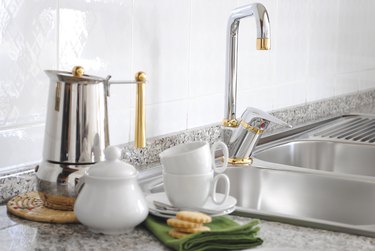
In This Article
Heavier than water, lye is a popular chemical often used to clear clogged drains. Because it doesn't float, you can use lye in drains even when there is standing water present. The lye will sink to the bottom of the drain and clear the clog quite effectively. Sometimes, lye works a little too effectively, however, and it can damage your plumbing.
When to Avoid Lye
Video of the Day
Scientifically known as potassium hydroxide or sodium hydroxide, lye does an excellent job of cutting through organic matter, like hair and other common drain cloggers. Unfortunately, it generates heat as it does so, making it best to avoid using lye in PVC and other plastic pipes. Although it won't melt them, lye is still highly corrosive and can damage cast iron pipes as well. As such, you should only use lye as a last resort even if your pipes are metal.
Video of the Day
Lye can help with very slow drains but never use it in a drain that you suspect to be clogged solid. Lye that encounters a solid clog will accumulate there. The longer it stays in one place, the more likely it is to damage your plumbing. Finally, avoid lye if you have a septic system. Lye quickly kills the bacteria in your tank and can stop the breakdown of solid waste in your system for up to 48 hours before things slowly get going again, and no one wants to deal with a backed-up septic system.
Things You'll Need
How to Clean a Drain With Lye
When using lye to open a drain, always read the directions on the product label first. While the basics of lye use are generally the same, every manufacturer may have its own special instructions for its product. Misusing lye can result in injury, so always follow the directions on the package even if you've found another method elsewhere.
Step 1: Prepare Yourself
Lye is an extremely caustic chemical, and it can burn your skin if you come into direct contact with it. To protect yourself, always wear protective gear when using it.
- Put on a pair of chemical-resistant safety glasses.
- Wear nitrile or latex gloves when handling lye.
Step 2: Add the Lye
If you are adding lye to a sink or tub full of standing water, make sure the water is cold. If it isn't, leave it to sit or add cold water until it is. Lye gets hot enough to boil water as it works in the drain, so it's important to start out with cold water rather than making hot water even hotter.
Pour 1 heaping tablespoon of lye crystals into the drain. Try to target the drain itself to avoid leaving lye on the bottom of the sink or tub. It can cause damage if left on these surfaces.
Follow the lye with 1 cup of cold water. If you have standing water, you can skip this step.
Place a bucket upside down over the drain. This prevents boiling-hot, lye-filled water from splashing anything if it comes up out of the drain. Set the bucket lip on its handle so the bucket creates a tight seal.
Allow the lye to sit in your drain for 15 to 30 minutes.
Step 3: Rinse and Repeat
In many instances, lye works extremely well, and one treatment is enough to get the job done. Once in a while, however, you have to add a second batch of lye to remove tough clogs. If the second treatment doesn't do it, you'll need to call a plumber. Don't just keep dumping increasing amounts of lye down the drain.
- Remove the bucket from your drain and flush it with cold water. Skip the flushing step if you still have standing water.
- Add another tablespoon of lye to the drain if the water still drains slowly as you flush out the lye or if you still have standing water. When adding a second batch of lye to standing water, be very careful not to splash. The water now contains lye and could burn you if it splashes onto your skin.
- Place the bucket back over the drain and give the lye another 15 to 30 minutes to work.
- Flush the drain with cold water. If it's still slow or if standing water remains, call a plumber. When you do, make it a point to tell him that you used lye in the drain. This will allow him to protect himself from any lye still present.